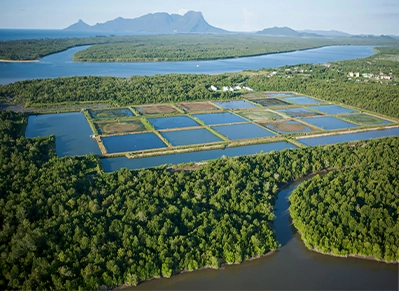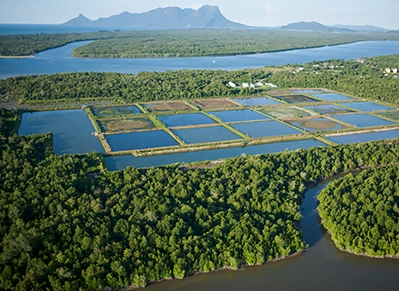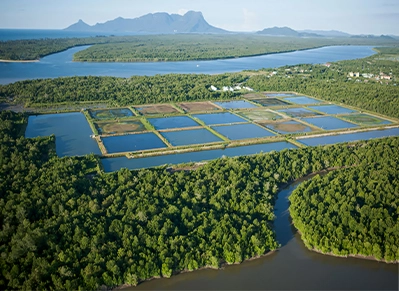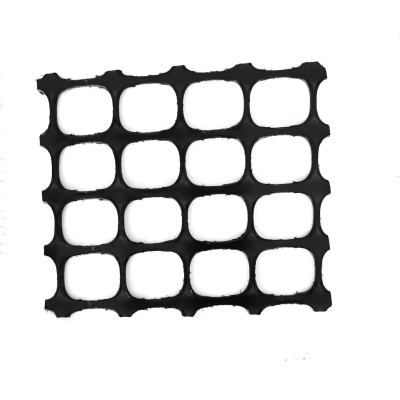Beyond Drainage: How Haoyang's Composite Nets Stabilize Slopes, Prevent Erosion & Cut Costs
Composite drainage net for slope protection is a geosynthetic material specially designed for slope (slope protection) engineering to efficiently collect and remove water inside or at the interface of the soil. It is a very important drainage element in modern civil engineering (especially geotechnical engineering and water conservancy engineering).
In simple terms, it is a "sandwich" structure:
1. Core: three-dimensional drainage net core
A grid with a three-dimensional spatial structure made of high-molecular polymers such as high-density polyethylene through a special process.
This three-dimensional structure provides a continuous and unobstructed water channel that can quickly collect and drain the infiltrated water from the soil or the water retained at the interface.
It has high compressive strength and open porosity (void ratio ), it can maintain water conductivity even when subjected to large earth pressure or construction load.
2. Outer layer: filtration layer (geotextile)
A layer of geotextile (usually polyester or polypropylene non-woven fabric) is covered on one or two surfaces of the three-dimensional mesh core by thermal bonding, needle punching or lamination.
The main function of this layer of geotextile is filtering: allowing water to flow freely into the drainage mesh core, while preventing the surrounding soil particles (fine-grained soil) from being brought in by the water flow and blocking the gaps in the mesh core, thereby maintaining the smooth flow of the drainage channel for a long time (i.e. preventing siltation).
At the same time, it also plays a certain isolation role to prevent different soil layers from mixing with each other.
Why is it needed in slope protection projects? Core functions:
1. Reducing pore water pressure: When rainfall or groundwater seeps into the slope soil, pore water pressure will be generated between soil particles. This pressure will significantly reduce the shear strength of the soil (making the soil "soft"), which is one of the main reasons for slope instability (landslide, collapse). The composite drainage net can quickly drain water, effectively reduce pore water pressure, and significantly improve the stability of the slope.
2. Prevent frost heave and thaw settlement: In cold areas, the water in the soil freezes and expands (frost heave), and settles after melting (thaw settlement), which will destroy the slope structure. The drainage net can reduce the water content in the soil and reduce the damage of freeze-thaw.
3. Accelerate soil consolidation: For newly filled slopes or slopes on soft foundations, the drainage net can accelerate the dissipation of excess pore water pressure, promote soil consolidation, improve the bearing capacity of the foundation, and reduce later settlement.
4. Protect waterproof/anti-seepage structure: Behind structures with impermeable layers (such as geomembranes) such as retaining walls, tunnel linings, and landfill liners, accumulated water will generate hydrostatic pressure, which may damage the impermeable layer. The drainage net is attached to the back of the impermeable layer, which can collect and discharge the leaking water in time, protect the impermeable layer and eliminate the hydrostatic pressure.
5. Replacement of traditional drainage materials: Compared with traditional sand and gravel drainage layers, composite drainage nets have significant advantages such as thin thickness, light weight, high drainage efficiency, convenient construction, space saving and cost saving.
Typical application locations in slope protection:
1. Behind rigid structures such as retaining walls, tunnel linings, and culverts (as drainage layers).
2. Inside or at the foot of slopes such as roadbeds, embankments, cuttings, and mines.
3. The bottom or top of geomembrane impermeable layers (such as landfill cover layers or liner systems).
4. In vegetation slope protection systems, below the cover layer or planting soil layer (playing both drainage and protection roles).
5. In soft foundation treatment that requires accelerated drainage and consolidation.
Main advantages:
1. High drainage efficiency: The three-dimensional mesh core provides a large and continuous water-conducting space.
2. Long-term effectiveness: The geotextile filter layer effectively prevents clogging.
3. High strength: It can withstand loads during the construction period and service period.
4. Durability: It is resistant to chemical corrosion, biodegradation and weather resistance.
5. Lightweight: It is easy to transport, carry and lay.
6. Space saving: A very thin thickness can achieve the drainage effect of a traditional thick gravel layer.
7. Simple and fast construction: It greatly reduces the amount of earth excavation and backfilling.
8. High overall cost-effectiveness: Although the unit price may be higher than that of sand and gravel, the total cost is usually more advantageous considering the materials, transportation, construction efficiency and space saving.
Why Choose Haoyang’s Composite Drainage Net?
1. 3D Hydraulic Architecture
Choose Haoyang for patented diamond grid drainage nets achieving 4500 m² day transverse flow capacity even at 45 degree slopes preventing hydrostatic pressure buildup that causes landslides
2. Mechanical Reinforcement
Our biaxial geonet core fused with nonwoven filtration layers delivers 25 kN m tensile strength anchoring vegetation roots while resisting 300 kPa earth pressures certified to ASTM D6706 standards
3. Erosion Control Superiority
Field validated in typhoon regions reducing surface runoff velocity 70 and soil loss 90 versus conventional gabions as documented in Malaysian highway embankment projects
4. Rapid Deployment Advantage
Pre assembled 4m wide rolls with peel and stick connectors enable 800 m² daily installation accelerating project timelines 3x and cutting labor costs 50
5. Ecological Integration
UV stabilized polymers support sustainable revegetation with 95 native plant survival rates confirmed by Singapore slope rehabilitation trials
6. Technical Partnership
Receive free slope stability analysis using our proprietary SoilNet software simulating rainfall saturation scenarios to optimize net specifications for your geology.
Haoyang Environmental Technology redefines slope stabilization with our engineered composite drainage nets since 2008 featuring a diamond grid geonet core thermally bonded to nonwoven filtration layers this patented system delivers 4500 m² day transverse drainage capacity at 45 degree inclinations eliminating hydrostatic pressure while the 25 kN m tensile strength anchors vegetation roots and resists 300 kPa earth pressures validated across typhoon prone Southeast Asia and arid mining slopes our 4 meter wide rolls with peel stick connectors enable 800 m² daily installation reducing labor costs 50 and slope failure risks by 93 7 per ISO 13249 standards request your free slope stability simulation leveraging 15 years of geosynthetic innovation to transform vulnerable embankments into permanently secured ecosystems.










